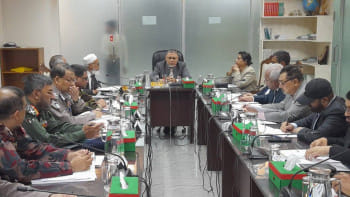Sylhetis, Assamese, 'Bongal Kheda', and the rolling thunder in the east

In these Trumpian times, the northeast of the South Asian subcontinent does not grab headlines. Nothing of significance usually happens there to warrant that. Particularly when the idiosyncrasies of the lead global personality, Mr Donald Trump himself, are so preponderantly dominating in that regard.
Directly opposite geographically in the subcontinent's periphery strides the northwest frontiers across the region's terrain. The Great Game involving Russia and Afghanistan, the lore of Rudyard Kipling's life and lyrics, and the tales of the Taliban inspire both interest and romance in a way that the northeast has failed to do.
The Chinese invasion of October 1962 was pretty much the last time that region was in global media focus. The Chinese themselves seemed eager to limit their exposure to that region to a very short time effecting a rapid withdrawal, and not due to India's military prowess or pressure! That situation of relative media obscurity may be changing but, alas, not in a favourable way. A crisis is brewing involving the National Register of Citizens in Assam as a perceptible tool for giving effect to "Bongal Kheda" ("Drive out Bengalis" in the Assamese language), a situation that may be poised to attract the world's attention. That could be akin to a rolling thunder from the east, signalling a possible storm!
However, Puranic history does not record that kind of neglect of these parts. Duryadhana, the eldest of the Kaurava siblings, in the epic Mahabharata is said to have married into the contemporary Habiganj district of the Sylhet Division of what is now Bangladesh. The hero Arjuna was supposed to have travelled to Sylhet, to the part called the Jaynta hills, to recover his horse taken captive by a princess. But she was unimpressed by his heroism or hectoring, and the negotiations came to naught. Saddened by a sense of discomfiture, he wandered southwards to present-day Manipur, where he had better luck with Princess Chitrangada, immortalised by Tagore's dance-drama of that name.
In the medieval times by far the most prominent individual to travel to Sylhet and initiate its recorded history was the Sufi Saint, Hazrat Shahjalal. Around the fourteenth century, he wrested the then kingdom of Sylhet from the Hindu ruler, Gaur Govinda, settled down with his accompanying soldier-saints, the Auliyas, and propagated Islam of a syncretic variety, given his predilections derived from his Turco-Yemeni origins.
Drawn by the resultant favourable ambience many Afghans from the territories of the Delhi Sultanate were also attracted to settling down as the Saint's "humsaya", a Persian word meaning neighbour. This has led to claims by some modern-day Sylhetis, particularly around central Sylhet—the area of Hazrat Shahjalal's abode—of their Middle Eastern ancestry, a claim as justifiable perhaps as that of the Pathans in the northwest of their Judaic origins. In later times, the British accorded the central Sylhetis the status of "Nishkar Kasbah", meaning "revenue-free villages". It could be out of some kind of positive recognition of their "superior lineage" or because they were simply considered too fierce (like the Pathans of the northwest?) to risk collecting taxes from. Hence these Sylhetis were spared from "rendering unto Caesar what was Caesar's", which was a bit ego-lifting.
Whatever the veracity of the claims of separate ethnicity, verbal communication in the area was conducted in the Sylheti tongue, which was much more than just a dialect. That is because there is sufficient historical evidence of an early Sylheti script, closely related to the Devanagari writings. Historians differ as to how it began. SK Chatterji claims it came with the Auliyas. Professor AH Dani held it accompanied the Afghan settlements as it resembled symbols on Afghan coins. An early "Londoni"—a term currently used for the nearly half million Sylheti diaspora in the UK—Abdul Karim in the 1870s, returned home after a prolonged European sojourn and started the Islamia Press in Sylhet town to publish works in Sylheti. Initially their vocabulary-load had a large Persian component, but eventually the language melded into Bengali, which became culturally dominant, pitted against Assamese, spoken in the province that played such a key role in Sylhet's history.
Received wisdom has it that 1947 witnessed two major partitions in India; those of Punjab and Bengal. There was a lesser-known third one of Assam. In 1874 the rich tea-producing district of Sylhet was transferred from Bengal to Assam to buttress the latter's revenues. But due to the burgeoning strength of the Bengali culture in Sylhet (three-quarters of all Bengalis in Assam were soon to be Sylhetis), Bengali tended to become the dominant language of Assam. In 1945 the Assam Congress took a public position that unless the province was organised on the basis of Assamese language and culture, the survival of Assamese "nationality" would become impossible. Hence the Premier of the Assam, Gopinath Bordoloi, shed little tears when in the referendum held in July 1947, Sylhetis opted to join Pakistan (thus being hived off from its own sub-district Karimganj and the Sylheti-speaking district of Cachar which went to India).
The loss of Sylhet was not mourned in Shillong, the capital of Assam, as according to historian Amalendu Guha, it allowed for the rest of the province to be more "linguistically homogenous". In September 1947, the Governor announced in the legislature: "The (Assamese) are now masters of their own house...The Bengali no longer has the power, even if he has the will, to impose anything on the people of these hills and valleys that constitute Assam."
While the factors such as interests displayed even in mythology by significant Puranic characters, claims of mixed ethnicity, separate linguistic scripts, and a unique political history of shared Assam-Bengal linkages tended to impart a sense of distinctiveness on the Sylhetis, which had been stressed at different points, from time to time for a variety of reasons, the fact remains that circumstances have conclusively dictated that the Sylheti persona be totally subsumed into Bengali psyche and culture. Sometimes there is sentimental revivalism of the intrinsic Sylheti ethos in such diasporic fora as the Sylheti Project in the School of Oriental and African Studies in the UK. But these are mainly geared more to satisfy curiosities into the past than to be reflective of aspirations for the future.
The partition of Assam was not accompanied by the kind of blood-letting between Hindus and Muslims as the divisions of Bengal and Punjab were. Muslims and Hindus appeared to retain a congenial relationship in Sylhet, Cachar and the rest of Assam. The Sylheti Bengalis now having joined Pakistan, the initial "Bongal Kheda" movement which aimed to keep the province pristinely Assamese was largely directed against Bengali Hindus. They were from both East and West Bengal, the latter now a state of India. Eventual demographic development led to Muslim Bengali population growth. Tensions of a communal nature resulted in the killing in Nellie in central Assam of over 2,000 Bengali Muslims on February 18, 1983.
Eventually, the rise of right-wing Hindutva in the rest of the country and the passage of governance in Assam to the Bharatiya Janata Party under Chief Minister Sarbananda Sonowal, led to the preparation of a draft Register of Citizens. It left four million in Assam, largely Muslims, at risk of losing Indian citizenship. The Muslims involved were quickly described as "infiltrators" from Bangladesh. A feared outcome of a future resolution of the issue could be the eventual "pushback" of large numbers into Sylhet and other parts of Bangladesh. Bangladesh would surely resist. A fearsome scenario could follow. In comparison, the Rohingya crisis could, to one reputed analyst, look like a tea-party!
If ever the application of the adage that a stich in time saves nine was relevant to international politics, it is here and now. Unfortunately, the issue is transforming into an election year imbroglio in the domestic political scene of India. An ego-contest between India's Modi government and potential challengers like West Bengal's Mamata Banerjee appears to be brewing. As yet it is still an internal problem in India, but one that has huge potentials of spilling across frontiers. Even if informally at this stage, at "track one" level governmental parleys are not yet considered feasible, Delhi and Dhaka must engage themselves through a "track two" mechanism.
There is great merit in keeping the global media focus away from here for now and the future. On the tea-plantation-centric life so relevant in these environs, the famous secular and socialist author Mulk Raj Anand had penned a novel entitled Two Leaves and a Bud, a popular description of a tea plant. Allegorically expressed, if Bengalis and Assamese are "the two leaves", the "bud should represent the fruition of their sense of togetherness."
Dr Iftekhar Ahmed Chowdhury is a former foreign adviser to a caretaker government of Bangladesh and is currently Principal Research Fellow at the Institute of South Asian Studies, National University of Singapore.

 For all latest news, follow The Daily Star's Google News channel.
For all latest news, follow The Daily Star's Google News channel. 



Comments